EPT: In search of a few good species
So we can use richness and %dominance to characterize the stream habitat.  But RBA goes a step farther. We know that certain species, including those in the Ephemeroptera (mayflies), Plecoptera (stoneflies), and Trichoptera (Caddisfly) orders, can only live in a really good environment -- they need cool, clean water with plenty of oxygen. (Together, we call them the EPT species, after the initials of their Latin names. Catchy, no?) They are also the preferred breakfast, lunch, and dinner of trout and other large fish. In fact fishermen make lures imitating mayflies and stoneflies, which tells you that the trout fishing lobby will be a big supporter of clean streams.
But RBA goes a step farther. We know that certain species, including those in the Ephemeroptera (mayflies), Plecoptera (stoneflies), and Trichoptera (Caddisfly) orders, can only live in a really good environment -- they need cool, clean water with plenty of oxygen. (Together, we call them the EPT species, after the initials of their Latin names. Catchy, no?) They are also the preferred breakfast, lunch, and dinner of trout and other large fish. In fact fishermen make lures imitating mayflies and stoneflies, which tells you that the trout fishing lobby will be a big supporter of clean streams.
There are thousands of species within the 3 EPT orders, just like there of many species of hawks or owls. All of them spend their early life in the stream. In fact, they look nothing like flies during this time period -- after all, wings are not terribly helpful if you live in the water! But like all insects, they have an exoskeleton, a segmented body, and 6 jointed legs. Here they are:
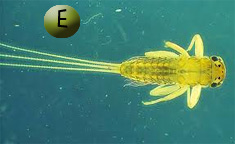 |
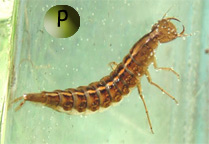 |
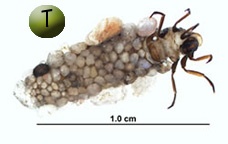 |
| mayfly (1 of > 2000 species) | stonefly (1 of >1600 species) | caddisfly (1 of >12000 species) |
They live in the stream because there is a lot of food there, and they cling to rocks to avoid getting tumbled downstream in the flow. Mayflies eat algae and detritus (decaying matter), while stoneflies eat mayflies and other small aquatic insects.
Mayflies and stoneflies have hydrodynamically flattened bodies and use tiny claws to cling to rocks. Caddisflies have a different strategy. Most of them build a small case (about 1 - 2 centimeters in length) out of sand grains or bits of sticks or leaf particles -- every species has its own particular design. They cement the case to a rock, then lay inside it and spin a kind of net (a bit like a spider web) which catches tiny particles floating by in the water, and this is what they eat. Because of the net, we call them "filter feeders".
 |
 |
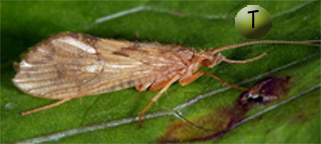 |
| mayfly (1 of > 2000 species) | stonefly (1 of >1600 species) | caddisfly (1 of >12000 species) |
Mayflies, stoneflies, and caddisflies can live in the stream from months to years, depending on the species. Eventually they metamorphose into adults, complete with wings. Mayflies in particular have delicate shimmering wings, but they lack a few other body part that we normally think of as essential -- a working mouth and a digestive tract. In fact, adult mayflies can't eat at all, and live only long enough to swarm over the stream, mate, and lay eggs in the water -- from a few hours to a few days at the longest.
Stoneflies do have working mouths, but they too live only a few weeks, and become vegetarians to boot. Caddisflies also live for a few weeks, and feed on flower nectar.
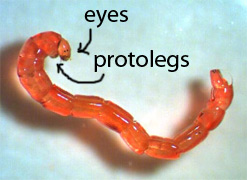 So now you know a little about the cream of the crop -- the elite of the stream insect world. But there are lots of other species living there as well. In fact, most other species are more tolerant of polluted, stagnant, warm, low-oxygen water. For example, there are about 15,000 species of chironomids (non-biting midges) world wide. Chironomids are abundant in most streams in North America, but they are quite small -- nearly microscopic -- and not nearly as exciting to the rest of the food chain as one of the EPTs. (The guy at the right is probably only a few millimeters long in real life.)
So now you know a little about the cream of the crop -- the elite of the stream insect world. But there are lots of other species living there as well. In fact, most other species are more tolerant of polluted, stagnant, warm, low-oxygen water. For example, there are about 15,000 species of chironomids (non-biting midges) world wide. Chironomids are abundant in most streams in North America, but they are quite small -- nearly microscopic -- and not nearly as exciting to the rest of the food chain as one of the EPTs. (The guy at the right is probably only a few millimeters long in real life.)
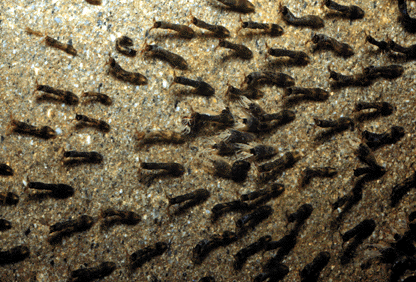
The most tolerant of all are usually blackfly larvae (yup, the ones that bite you when they grow up) and aquatic worms. If your stream is full of chironomids, blackflies, and worms, you know it's in trouble!
Copyright University of Maryland, 2007
You may link to this site for educational purposes.
Please do not copy without permission
requests/questions/feedback email: mathbench@umd.edu